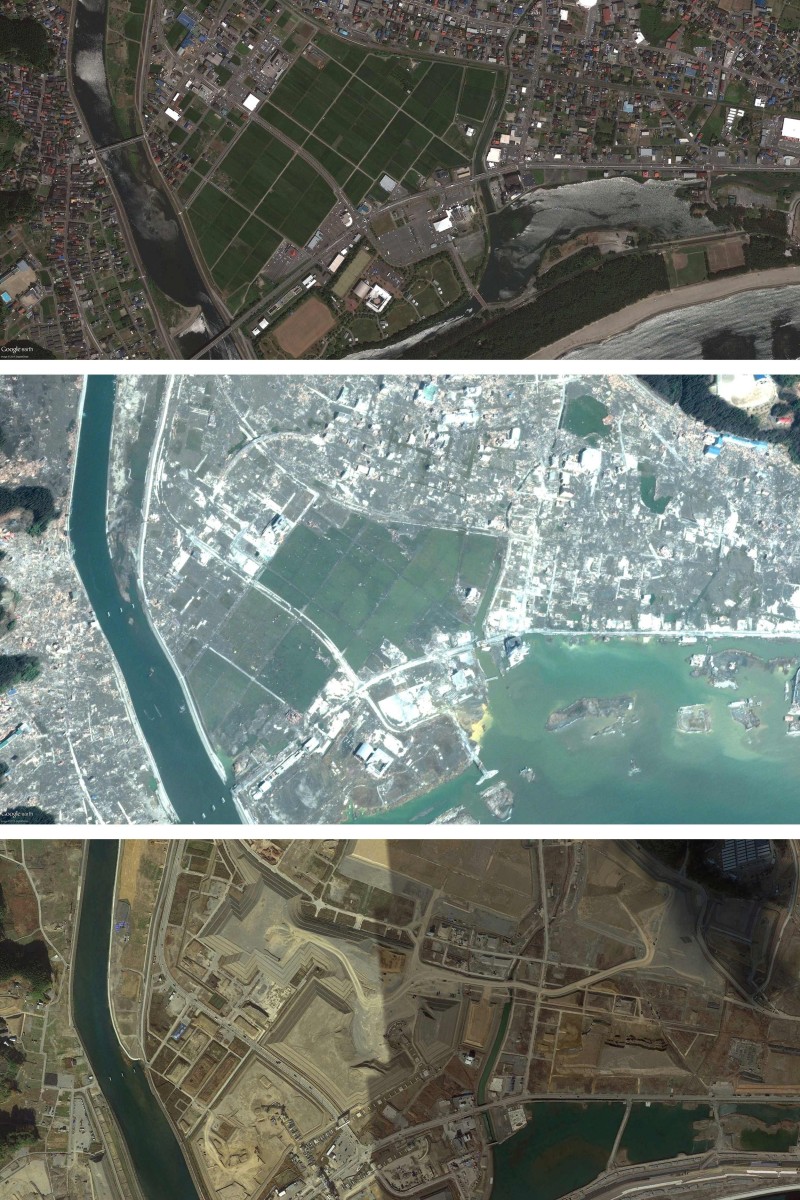 Satellite images of the Japanese city of Miyako in Iwate prefecture from July 19, 2009 (top), March 13, 2011 (C), two days after the tsunami, and on February 26, 2016 (bottom), nearly five years after.
Satellite images of the Japanese city of Miyako in Iwate prefecture from July 19, 2009 (top), March 13, 2011 (C), two days after the tsunami, and on February 26, 2016 (bottom), nearly five years after.Other stories on the 2011 Japan tsunami:
-
Fukushima: Dads still looking for missing kids
-
From journalists' perspective: Memories of the 2011 Japan tsunami and earthquake
In short
- March 11, 2016 is the five-year anniversary of the Fukushima disaster
- A magnitude 9 earthquake struck off the coast of Japan
- It was followed by a massive tidal wave that damaged the Daiichi nuclear power plant
- Unable to use coolants, the plant had three nuclear meltdowns
- The plant began releasing radioactive material on March 12
The eye in the sky tells the story: satellite imagery from Japan's tsunami-ravaged Pacific coast shows the catastrophic result of communities destroyed five years ago - and their struggle to recover even now.
Walls of sea water inundated a wide swathe of the country's northeast on March 11, 2011 after a magnitude 9.0 earthquake upended the ocean floor.
They also triggered reactor meltdowns at the Fukushima Daiichi power plant, in the worst nuclear disaster since Chernobyl in 1986, spreading radioactive contamination over a wide area.
While cities and towns farther north escaped the worst of the nuclear fallout, their landscapes were among the most devastated, and, as Japan marks the fifth anniversary of the disaster on Friday, many are still barely recovering.
The tsunami destroyed buildings, swept entire homes out to sea and hurled seagoing vessels of iron and steel onto land as if they were toys thrown about by children.
About 16,000 people are known to have died and some 2,600 people are missing, presumed dead. Satellite pictures of the city of Miyako taken on March 13, 2011 and released by Google as part of a digital archive, reveal wide tracts of land covered in brown muck.
Another taken late last month shows the landscape still stained by the same colour, but other areas where efforts to rebuild have borne fruit.
Two days after the tsunami the Hachiman River flowed through Minamisanriku, a city smothered in a mess of mossy green and chalky white - colours dumped when the ocean rolled ashore.
An image taken in November last year reveals a cityscape mostly cleared, though still dusty brown and awaiting redevelopment.
In Kesennuma, the huge red-hulled ship that the ocean dumped ashore - and which for many became a symbol of the power of the tsunami - has gone, revealing again the green hills of the town.
But the visible remnants of the disaster tell only part of the story of misery wrought by nature's fury.
In the seaside hamlet of Tomioka, six kilometres from the shuttered nuclear plant at Fukushima, unseeable - though measurable - radiation haunts the land.
Tomioka is still dotted with the carcasses of destroyed homes and wrecked vehicles, the clean-up slowed by the tiny, but dangerous atomic particles that infest the earth.
How Japan's students responded
"Many from my town have lost hope of returning,” said Yuji Takahashi, 72, who used to live in the community where citizens gathered under cherry blossoms in spring and held a fire festival in summer to pray for a good harvest.
Trucks and construction vehicles roar along a road where a digital panel shows radiation readings, while cranes haul big black plastic bags full of contaminated waste.
The situation is better in Minamisoma, where lower radiation levels have allowed residents to return.
Five years ago the powerful waves of the tsunami ripped off roofs and tore homes from their foundations, leaving a landscape reminiscent of Japan’s bombed out ruins at the end of the second world war.
Now parts of the city, 30 kilometres north of the plant, buzz with the sound of bulldozers, while reconstruction and decontamination workers fill its hotels.
Minamisoma plans to build an industrial complex, set up solar panels and allow farmers to grow rice on cleared land where the government says radiation levels are safe, as it tries to lure back residents.
Former evacuee Sayuri Tanaka works at a community cafe serving young mothers and babies just metres away from the construction site.
She left the city for three years mainly due to fears over the impact of radiation on her six-year-old daughter, but ultimately decided to return.
She is at peace about her decision to return home.
"It is more important for me to take a step forward than to keep worrying."
